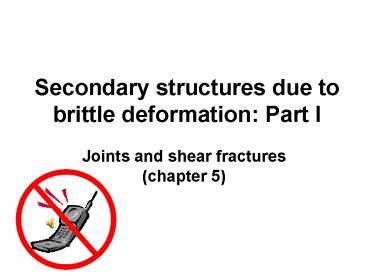Secondary structures due to brittle deformation: Part I - PowerPoint PPT Presentation
1 / 15
Title:
Secondary structures due to brittle deformation: Part I
Description:
Secondary structures due to brittle deformation: Part I. Joints and shear ... Joint data from the Hausz Bros. Quarry. Collected by Ryan F. and Shane D. ... – PowerPoint PPT presentation
Number of Views:98
Avg rating:3.0/5.0
Title: Secondary structures due to brittle deformation: Part I
1
Secondary structures due to brittle deformation
Part I
- Joints and shear fractures (chapter 5)
2
- FRACTURE
- General term for a surface across which material
continuity is lost. - Can be microscopic to continental in scale
- Fractures can be divided into two broad types
depending on whether there was any PERCEIVABLE
relative movement along the surface
3
- When there is definite (measurable) movement
along a fracture surface, it is called a FAULT
4
- When there is imperceptible movement along
fracture surface, it can either be - JOINTS (fracture walls pull apart, page 204)
- SHEAR FRACTURES (imperceptible shear along
fracture walls, page 206)
5
Joints Why bother? (pages 210-214)
- Channels for fluid circulation
- Rainwater and/or groundwater movement
- Pollutant transport
- Hydrothermal fluids containing economic minerals
- Oil and natural gas
6
Controls rock strength
- Controls weathering/erosion patterns
- Helps quarrying
- May cause rockfalls or landslides
7
Formation of joints
- Joints are MODE I or opening fractures (page 221)
- Walls move away perpendicular to the direction of
maximum compression, s1 - Mode I fractures are oriented perpendicular to
the direction of maximum tension, s3
FYI s1, s2 and s3 define the STRESS FIELD at
any point and they are mutually perpendicular to
each other (more later)
8
s1
Mode I fracture
s1
s3
s3
Fracture opens
s1
s1
9
Joint sets and joint systems (pages 205-206)
- Systematic joints
- Planar joints that comprise a family in which
- all the joints are parallel or subparallel to one
another, and - maintain roughly the same average spacing over
the region of observation
10
- Nonsystematic joints (page 206)
- tend to be nonplanar
- they do not parallel neighboring joints, and
- they have an irregular spatial distribution
11
- A joint set (page 205) is a group of systematic
joints - Joint system (pages 205-206) Happens when two or
more joint sets intersect at fairly constant
angles (dont confuse it with systematic joints) - The angle between two joint sets in a joint
system is called dihedral angle.
12
Joint data from the Hausz Bros. Quarry Collected
by Ryan F. and Shane D. Number of data points
40 Outer circle 10
Is this an example of a single joint set or joint
system?
What is the approximate dihedral angle?
13
Joint data from the Hausz Bros. Quarry Collected
by Derek W. and Kristin A. Number of data points
40 Outer circle 20
How is this dataset different from the previous
one?
Is this a significant difference?
14
- If the dihedral angle is 90 between two joint
sets, the pair is called an orthogonal system - If the two joint sets intersect with a dihedral
angle significantly less than 90 (e.g., a
dihedral angle of 30 to 60), the pair is called
a conjugate system
15
Joint data from the Hausz Bros. Quarry Collected
by Ryan F. and Shane D. Number of data points
40 Outer circle 10
Joint data from the Hausz Bros. Quarry Collected
by Derek W. and Kristin A. Number of data points
40 Outer circle 20
Is there a significant difference between the
dihedral angles of these datasets?































